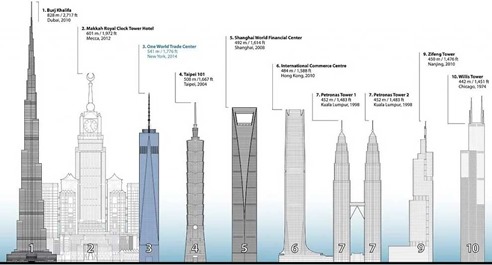InterestingEngineering.com is always educational and informative
Posted By RichC on September 19, 2015
It’s probably being marveled by all things engineering that has me gravitating daily to the Interesting Engineering website and I probably browse longer than I should through the educational and “interesting” posts.
Image Courtesy of Council on Tall Buildings and Urban Habitat
Architecture, skyscrapers and buildings around the world are a monumental undertakings and amazing engineering feats. The desire to build grandiose structures go far back as as the Egyptian pyramids and has continued to this day all around the world. Check out Top Ten Tallest Buildings.
Burj Khalifa, Dubai – 828 meters (2691 feet)
As remarkably tall buildings proliferate, the engineering challenges mount as well. Early on, the primary issue engineers faced was the materials themselves. Stone can only be stacked so high, even if it’s done to amazing effect, as with the Chartre Cathedral in France. The breakthrough came in the late 19th century, at the hands of the American engineer/architect William La Baron Jenney. Born in the U.S., Jenney went to France for his formal engineering and architectural education, graduating from the prestigious l’École Centrale des Arts et Manufactures in Paris; he was classmates with Gustave Eiffel, the designer of his namesake tower. Perhaps that association had something to do with the innovation Jenney devised in 1884 when he conceived and built the 10 story Home Insurance Building in Chicago, Illinois – The world’s first skyscraper.
That iconic structure was the first building framed with metal columns and beams, overcoming previous limitations in one elegant stroke, and producing a structure some 65% lighter than an equivalent made of stone or brick. That weight savings was the key to ever taller structures to come, as colleagues grasped the magnitude of Jenney’s revelation and advanced upon his work. He expanded on his work through the end of the century, and passed away in 1907.
The curtain wall, a direct descendant of Jenney’s innovation, is a ubiquitous feature in skyscrapers. Rather than employing load bearing walls as conventional construction does, curtain walls are born by or suspended from the load bearing framework, allowing a wide variety of exterior shapes and surfaces – The glass walled skyscraper is a direct result of such innovation. The load bearing frameworks of the tallest buildings are all derivations of a tubular core, allowing the building not only its height, but the ability to resist lateral loads from wind and seismic forces.
While common key elements of design and construction allow soaring towers to proliferate, each project presents myriad complex issues that are simple considerations in lesser structures. Everything from HVAC to moving people between floors require highly detailed modeling prior to hard design and construction. High powered computers and software have clearly become must-have tools of the trade.

Comments